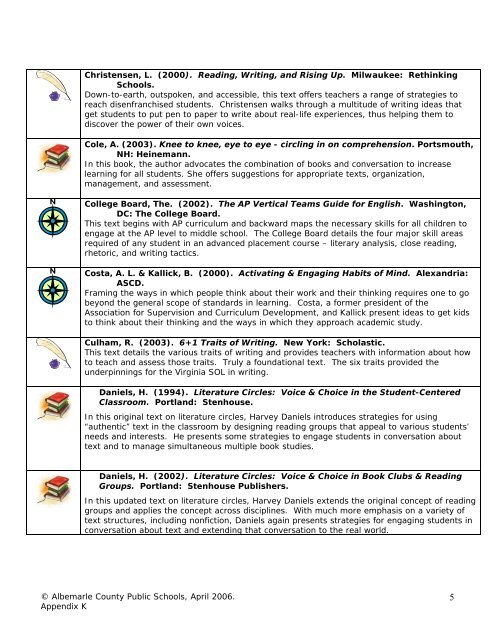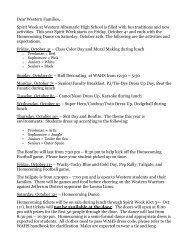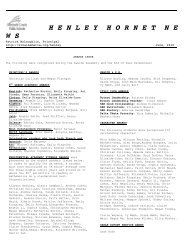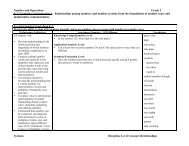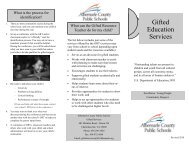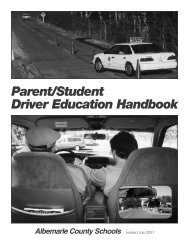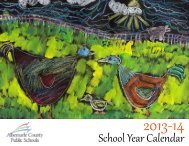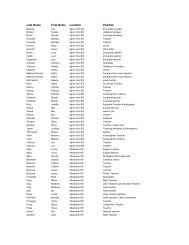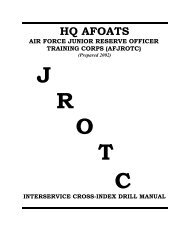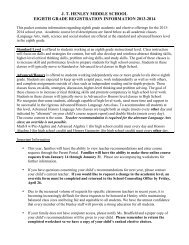Language Arts/English Curriculum Frameworks - Albemarle County ...
Language Arts/English Curriculum Frameworks - Albemarle County ...
Language Arts/English Curriculum Frameworks - Albemarle County ...
You also want an ePaper? Increase the reach of your titles
YUMPU automatically turns print PDFs into web optimized ePapers that Google loves.
Christensen, L. (2000). Reading, Writing, and Rising Up. Milwaukee: Rethinking<br />
Schools.<br />
Down-to-earth, outspoken, and accessible, this text offers teachers a range of strategies to<br />
reach disenfranchised students. Christensen walks through a multitude of writing ideas that<br />
get students to put pen to paper to write about real-life experiences, thus helping them to<br />
discover the power of their own voices.<br />
Cole, A. (2003). Knee to knee, eye to eye - circling in on comprehension. Portsmouth,<br />
NH: Heinemann.<br />
In this book, the author advocates the combination of books and conversation to increase<br />
learning for all students. She offers suggestions for appropriate texts, organization,<br />
management, and assessment.<br />
College Board, The. (2002). The AP Vertical Teams Guide for <strong>English</strong>. Washington,<br />
DC: The College Board.<br />
This text begins with AP curriculum and backward maps the necessary skills for all children to<br />
engage at the AP level to middle school. The College Board details the four major skill areas<br />
required of any student in an advanced placement course – literary analysis, close reading,<br />
rhetoric, and writing tactics.<br />
Costa, A. L. & Kallick, B. (2000). Activating & Engaging Habits of Mind. Alexandria:<br />
ASCD.<br />
Framing the ways in which people think about their work and their thinking requires one to go<br />
beyond the general scope of standards in learning. Costa, a former president of the<br />
Association for Supervision and <strong>Curriculum</strong> Development, and Kallick present ideas to get kids<br />
to think about their thinking and the ways in which they approach academic study.<br />
Culham, R. (2003). 6+1 Traits of Writing. New York: Scholastic.<br />
This text details the various traits of writing and provides teachers with information about how<br />
to teach and assess those traits. Truly a foundational text. The six traits provided the<br />
underpinnings for the Virginia SOL in writing.<br />
Daniels, H. (1994). Literature Circles: Voice & Choice in the Student-Centered<br />
Classroom. Portland: Stenhouse.<br />
In this original text on literature circles, Harvey Daniels introduces strategies for using<br />
“authentic” text in the classroom by designing reading groups that appeal to various students’<br />
needs and interests. He presents some strategies to engage students in conversation about<br />
text and to manage simultaneous multiple book studies.<br />
Daniels, H. (2002). Literature Circles: Voice & Choice in Book Clubs & Reading<br />
Groups. Portland: Stenhouse Publishers.<br />
In this updated text on literature circles, Harvey Daniels extends the original concept of reading<br />
groups and applies the concept across disciplines. With much more emphasis on a variety of<br />
text structures, including nonfiction, Daniels again presents strategies for engaging students in<br />
conversation about text and extending that conversation to the real world.<br />
© <strong>Albemarle</strong> <strong>County</strong> Public Schools, April 2006.<br />
Appendix K<br />
5


